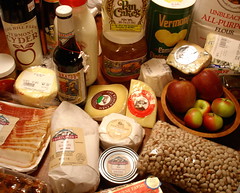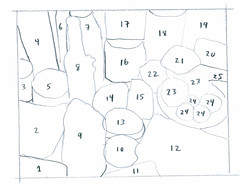Boston Notebook
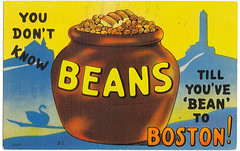 fig. a: You don't know beans...
fig. a: You don't know beans...
When M., our friend and Ultimate Boston Authority, titled her extensive run-down of the food scene in Boston "Beans & Tweed," we weren't exactly 100% sure what to make of it. I mean, yeah, we all know about Boston baked beans, but are they still just as central to the local imagination as they once were to the national imagination?
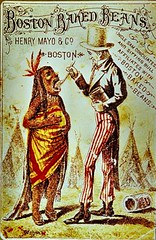 fig. b: Uncle Sam + Sitting Bull
fig. b: Uncle Sam + Sitting Bull
And, sure, I guess I can see the tweed connection, but what kind of Boston Tweed are we talking about?
Ivy League?
 fig. c: boss tweed
fig. c: boss tweed
 fig. d: bros. tweed
fig. d: bros. tweed
Retrosexual?
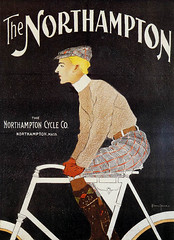 fig. e: tweed ride
fig. e: tweed ride
 fig. f: tweed rides again
fig. f: tweed rides again
Or this kind?
 fig. g: Boston tweed cat carrier
fig. g: Boston tweed cat carrier
Well, in the end, we didn't encounter a whole lot of beans or tweed. No beans, because we placed our emphasis on scoring some premium seafood. And no tweed, because it was somewhere close to 85º F when we arrived in Beantown. But M.'s "Beans & Tweed" guide to Boston was a treasure trove of tasty and tantalizing tips nonetheless.
Unfortunately for us, our trip to Boston (Michelle's first!) was exceedingly short, and the stated purpose of the visit had to do with attending a conference, but we still managed to squeeze in some great outings...
Toro
We were dead set on going to Toro for our first dinner in Boston. We'd heard great things, we were in the mood for top-notch tapas, we were thirsty for wine, and we were on another one of our crazy cross-border missions. This time involving a bread delivery (?).
When Michelle's colleague and fellow Twitterer Jeffrey Finkelstein heard that we were heading down to Boston, he asked us if we could do him a favour--drop off a batch of his exceptional Hof Kelsten bread to a friend of his: Ken Oringer, the owner and one of the co-chefs at Toro. We told him we'd been thinking about visiting Toro anyway. He told us that he'd make sure that he got us hooked up if we did. Right on!
So that's how we wound up hauling an industrial-size bag (literally) of bread from Montreal to Boston. This time the customs officials didn't even bat an eye.
Dropping off a load of bread didn't help to get us seated at Toro--it was Friday night and that joint was hopping!--but it did score us some attentive service and some lovely extras when we did.
Everything (and I do mean everything) we had was simply outstanding, but the highlights included the cauliflower a la plancha (with pine nuts and golden raisins), the whole salt-encrusted Mediterranean sea bass stuffed with herbs, the griddled garlic shrimp with Romesco, and their house special Latin American-style grilled corn with aioli, aged cheese, and espelette pepper. I know, I know: corn in March? Like Michelle says: just order it. It was totally off the hook--the very best grilled corn either of us had ever had.
Verdict: Olé!
Mr. Bartley's
Mr. Bartley's actually has a rather extensive menu, but their reputation rests on their assortment of "gourmet burgers." You might think the "gourmet" label might scare some people off, but, no--Mr. Bartley's burgers are unbelievably popular. The line-up outside stretched down the block at 2:30 in the afternoon.
When we saw the size of this queue, we figured we'd have to come up with a Plan B, but there were only two of us, so we decided to ask how long the wait was anyway. After all, we were both majorly jonesing for a burger. When the host told us "about 15 minutes" we thought he was having us on, but we decided to stick around to find out. Sure enough, 15 minutes later, we were seated, waiting for our gourmet burgers.
Mr. Bartley's isn't exactly a fast food joint--the burgers are much too generous (7 ounces!) for that. But it's pretty much as fast as it could possibly be, and it's an impressive operation to see in action. They take your order outside, when you're waiting in line. When you actually enter the premises, your order is set into motion, and is matched with your seating assignment. No time is wasted on customers lollygagging over the menu, and the ritual of ordering has been seriously streamlined. You still have a bit of a wait on your hands after you get seated, because these are big burgers and they're prepared with care, but Mr. Bartley's system allows them to cycle customers through the restaurant highly efficiently (hence, the miraculous "about 15 minutes" wait time). More importantly, they make a tasty, perfectly cooked burger, and the place has all the character you'd expect of a Harvard Square burger institution of its vintage (since 1960!). Plus, if it's good enough for the likes of Johnny Cash, Jacqueline Onasis, Bob Dylan, Joan Baez, Bill Belichick, Al Pacino, Adam Sandler, Tom Werner, and Katie Couric, it's good enough for you. It was definitely good enough for us.
Verdict: Rah! Rah! Rah!
Neptune
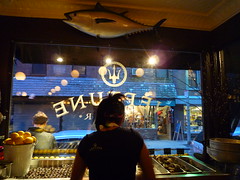 fig. h: Neptune
fig. h: Neptune
Easily the single biggest food highlight of the entire trip. Neptune was definitely a bit of a splurge, but it was absolutely worth it. We sat at the raw bar and took our sweet, sweet time, and when everything was said and devoured, Michelle proclaimed the meal one of her Top 5 restaurant meals of all time (!).
One of the reasons the meal was so much fun was because we avoided the main courses, and, instead, placed our focus on the raw bar and on a selection of accompanying appetizers and other side dishes (in retrospect, I guess we were still in tapas mode from the night before). We ended up doing two platters from the raw bar--both of them à la carte, both of them consisting mainly of New England oysters--and even that wasn't enough: Michelle ended up having an extra Jonah crab claw "for dessert" at the very end of our meal.
The oysters were simultaneously out of the world, and very much of it. They were so plump, so juicy, so sweet, and so wonderfully briny. We ended up having most of Neptune's East Coast offerings, including Cotuits (Cotuit, MA), Island Creeks (Duxbury, MA), and Wellfleets (Wellfleet, MA), but our favourites were the Ninigrets (Ninigret, RI) and the Thatch Islands (Barnstable, MA). Michelle had never had Jonah crab claws before, so she insisted, and I was all too happy to comply. I'd never had cracked crab without drawn butter, but those claws were pretty damn fine au naturel, and they were even better with a dab of Neptune's horseradish-laced cocktail sauce. Finally, I insisted on adding some clams to the mix, and I was pretty glad I did, because their cherrystones were the sweetest, most tender clams I've ever had.
Other delica-seas included the Wellfleet littlenecks steamed in Vermentino wine, with garlic and parsley, the Neptune Caesar, whose combination of lolla rossa lettuce, pecorino, lemon, and boquerones (yes!) may have made it my definitive restaurant Caesar salad, and Neptune's crudo special. Their crudo-of-the-day was striped bass from Virginia dressed with olive oil, chives, sliced red grapes, and verjus, and it was utterly masterful. It blew us away, and I'm sure it would have made Dave Pasternack proud.
Next time (and, let me tell you, there will be a next time) we're definitely going to split one of Neptune's lobster rolls, but, otherwise, I'd go about things pretty much exactly the same way.
Verdict: Ahoy!
Deluxe Town Diner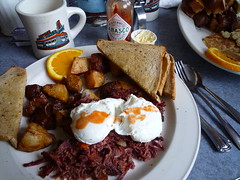 fig. g: deluxe!
fig. g: deluxe!
Sunday we were in the mood for a deluxe diner breakfast, and a deluxe diner breakfast is what we got. In fact, that was the name of the diner we went to: Deluxe Town Diner, in nearby Watertown, MA. New England still has its fair share of authentic early- to mid-20th-century diners, and the Deluxe Town Diner is one of them. And though the owners are clearly aware of their diner's retro charms, they haven't gone all Wowsville with it. Instead, the focus is on the food.
We were lured by rumours of honest-to-goodness, homemade Johnny Cakes, and they were truly excellent (especially when drizzled with their 100% pure Vermont maple syrup), but so was everything else: the corned beef hash, the home fries, the bottomless cups of coffee.
Verdict: Hubba hubba!
Mystery Train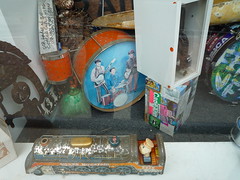 fig. h: all aboard!
fig. h: all aboard!
On our way back to the Great White North, we made a detour to Cape Anne to eat some more seafood, buy some saltwater taffy, and experience the charms of coastal New England, but the best stop of this jaunt was one of our first: Mystery Train Records in Gloucester, MA. (M. didn't steer us wrong [she never does].) Now that's what I call a record store. Definitely one of the best I've been to in years. Such a crazy hodge-podge of a collection, such reasonable prices, and such a great shopfront window. Classic record store dudes, too.
Verdict: Kick out the jams!
Toro, 1704 Washington St., Boston, MA 02118 (South End), (617) 536-4300
Mr. Bartley's, 1246 Massachusetts Ave., Cambridge, MA 02138 (Harvard Square), (617) 354-6559
Neptune, 63 Salem St., Boston, MA 02113 (North End), (617) 742-3474
Deluxe Town Diner, 627 Mount Auburn St., Watertown, MA 02472 (617) 926-8400
Mystery Train Records, 21 Main St. Gloucester, MA 01930, (978) 281-8911
aj






